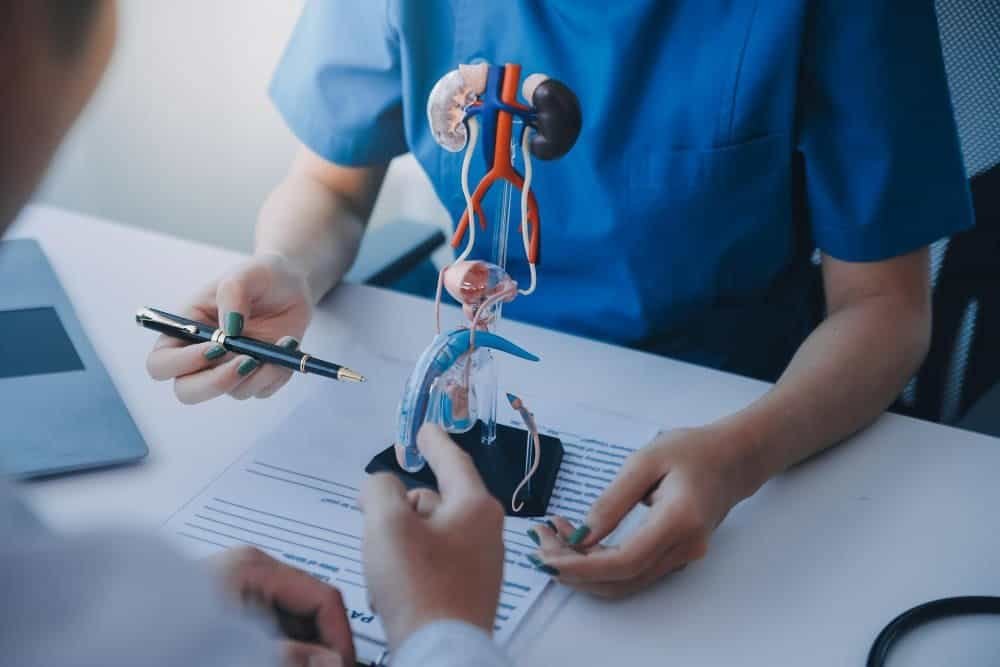Choosing a BPH treatment is a major decision. To help you understand your options, this article provides a detailed look at prostatic artery embolization vs turp, comparing everything from recovery time to potential complications, so you can find the best path forward for your health. 🤔

Prostatic Artery Embolization vs TURP: Which Treatment is Better for Benign Prostatic Hyperplasia?
When dealing with the frustrating urinary symptoms caused by an enlarged prostate, also known as benign prostatic hyperplasia (BPH), choosing the right treatment is a critical decision. For decades, the go-to surgical procedure has been Transurethral Resection of the Prostate (TURP). However, modern medicine has introduced a powerful, less invasive alternative: Prostatic Artery Embolization (PAE).
Understanding the differences between these two effective procedures is key to making an informed choice that aligns with your health needs and lifestyle goals. This article will compare these two treatments, examining everything from the procedure itself to recovery time, potential complications, and long-term functional outcomes.
What is TURP? The Traditional Surgical Approach
Transurethral Resection of the Prostate, or TURP, has long been considered the gold standard for treating moderate to severe BPH symptoms. It is an invasive surgical procedure designed to provide rapid relief from urinary issues.
The TURP procedure involves the surgeon inserting a resectoscope through the tip of the penis into the urethra. This instrument allows for the cutting and removing of excess prostatic tissue that is blocking urine flow.
This prostatic tissue resection creates a wider channel for urine to pass through, leading to immediate symptom improvements. The procedure requires either general anesthesia or spinal anesthesia and is performed by a urologist in a hospital setting.
There are two main types of TURP:
- M-TURP (Monopolar TURP): The original method, which uses an electrical current that flows from the instrument through the patient’s body to a grounding pad.
- B-TURP (Bipolar TURP): A more modern version where the electrical current is confined to the area between two electrodes on the instrument, reducing the risk of certain complications.
While effective, the invasive nature of TURP comes with a specific set of disadvantages and potential risks that every patient should consider.
The Downsides: Disadvantages and Complications of TURP
Although TURP can dramatically improve urinary symptoms, its benefits must be weighed against its potential drawbacks. Being a surgical procedure, it carries inherent risks that are significantly reduced with minimally invasive alternatives.
The primary disadvantages of TURP include:
- Invasive Nature: The procedure involves cutting and removing tissue, which leads to a higher risk of bleeding and a more demanding recovery.
- Anesthesia Requirement: It typically requires general anesthesia or spinal anesthesia, which has its own set of risks, especially for older patients or those with other health conditions.
- Hospitalization: TURP is not an outpatient procedure. It almost always requires overnight hospital stays, usually for one to three days, for monitoring.
- Longer Recovery Time: The recovery time after TURP can be lengthy, often taking several weeks before a patient can return to all normal activities. A catheter is usually needed for a few days after the surgery.
- Significant Blood Loss: The resection of prostate tissue can lead to substantial blood loss during and after the procedure, sometimes requiring a blood transfusion.
- TUR Syndrome: A rare but serious occurrence, Transurethral Resection (TUR) Syndrome happens when the body absorbs too much of the fluid used during the surgery. This can cause a dangerous imbalance of electrolytes. While less common with B-TURP, the risk still exists.
- Sexual Complications: One of the most common complications is retrograde ejaculation, where semen enters the bladder instead of exiting the penis during orgasm. While not physically harmful, it can be distressing for patients. There is also a small risk of erectile dysfunction (ED).
What is Prostatic Artery Embolization (PAE)? A Modern, Minimally Invasive Treatment 💡
Prostatic Artery Embolization (PAE) is a revolutionary, minimally invasive treatment for BPH that offers excellent results without the need for surgery. Performed by an interventional radiologist like Dr. Samir Abdel Ghaffar, the pae procedure focuses on shrinking the prostate gland rather than surgically removing tissue.
The treatment involves blocking the arteries that supply blood to the prostate. An interventional radiologist makes a tiny puncture, usually in the groin or wrist artery, and guides a microcatheter to the prostatic arteries. Tiny, sand-like particles are then injected to block, or “embolize,” these vessels. This decrease in blood flow causes the prostate gland to soften and shrink over several weeks, relieving the pressure on the urethra.
This entire process is performed under local anesthesia, meaning the patient is awake but comfortable. Because there is no cutting or resection of tissue, the procedure helps improve lower urinary tract symptoms with a much lower risk of major complications.
Key Advantages of Choosing PAE
The growing popularity of prostate artery embolization is due to its significant advantages over traditional surgery. Patients who undergo PAE benefit from a safer and more comfortable experience.
Key benefits include:
- Minimally Invasive: No cutting, no surgery, just a small puncture in the skin. This means less pain and no surgical scars.
- Quicker Recovery: The recovery time is remarkably fast. Most patients can return to normal, non-strenuous activities within a day or two.
- Shorter Hospitalization Times: PAE is often performed as an outpatient surgical procedure (OSP), meaning you can go home the same day. This avoids the need for costly overnight hospital stays.
- Fewer Complications: PAE has a much lower risk profile compared to TURP. The possibility of major bleeding, infection, and TUR syndrome is virtually eliminated.
- Preservation of Sexual Function: One of the biggest advantages is the low risk of sexual side effects. Rates of retrograde ejaculation and erectile dysfunction are significantly lower with PAE compared to TURP.
- Minimal Blood Loss: Because no tissue is cut, blood loss is negligible, making it a safer option for patients on blood thinners or those who cannot tolerate surgical bleeding.
Direct Comparison Table: PAE vs. TURP
To simplify the choice, here is a direct comparison of prostatic artery embolization vs turp.
| Feature | Prostatic Artery Embolization (PAE) | Transurethral Resection of the Prostate (TURP) |
|---|---|---|
| Procedure Type | Minimally invasive treatment; embolization of arteries | Invasive surgery; prostatic tissue resection |
| Anesthesia | Local anesthesia; patient is awake | General anesthesia or spinal anesthesia |
| Hospital Stay | Typically an outpatient procedure (go home same day) | Requires overnight hospital stays (1-3 days) |
| Recovery Time | Quicker recovery (1-2 days for light activity) | Longer recovery time (several weeks) |
| Blood Loss | Minimal to no blood loss | Significant blood loss is a known risk |
| Complications | Low risk; fewer serious adverse events (AEs) | Higher risk; possibility of TUR syndrome, bleeding |
| Sexual Function | Very low risk of retrograde ejaculation or ED | High risk of retrograde ejaculation; small risk of ED |
| Symptom Relief | Gradual improvements over weeks as prostate shrinks | Immediate symptom improvements post-surgery |
Analyzing Functional Outcomes and Success Rates 🤔
When evaluating “how successful is prostate artery embolization?”, the evidence is compelling. Numerous studies have demonstrated that PAE provides significant and durable improvements in BPH symptoms. Functional outcomes are measured using objective parameters like the International Prostate Symptom Score (IPSS) and quality of life (QoL) scores.
Patients undergoing PAE experience a substantial decrease in their IPSS, reflecting major relief from urinary frequency, urgency, and weak stream. While TURP might offer more immediate symptom improvements because the obstructing tissue is physically removed, the long-term outcomes of PAE are comparable. Many patients find the gradual, steady improvement from PAE preferable, especially when coupled with its superior safety profile and quicker recovery.
Patient Selection: Who is a Good Candidate for Each Procedure? 👨⚕️
Proper patient selection is crucial for achieving the best results. The choice between pae vs turp is not one-size-fits-all and should be made after a thorough consultation.
PAE is an excellent option for:
- Men with moderate to severe BPH symptoms.
- Patients with larger prostate glands, where surgery might be more complex.
- Men who wish to avoid the sexual side effects associated with TURP.
- Older patients or those with other health conditions that make them poor candidates for surgery under general anesthesia.
- Patients who want to avoid hospitalization and desire a quicker recovery.
TURP is typically considered for:
- Men with severe symptoms who desire the most immediate relief possible.
- Patients with certain anatomical variations of the prostate or bladder that might make PAE less suitable.
- Individuals who are good surgical candidates and are willing to accept the associated risks and longer recovery time.
Exploring the Landscape: How Does PAE Compare to Other Treatments?
The world of BPH treatment is expanding, and it’s helpful to see where PAE stands among other modern options.
- PAE vs Urolift: Both are minimally invasive. UroLift is a mechanical implant system that holds tissue back, while PAE shrinks the entire gland. PAE is often preferred for larger prostates where UroLift may be less effective.
- HoLEP vs TURP: Holmium Laser Enucleation of the Prostate (HoLEP) is another surgical option similar to TURP but uses a laser. It can handle very large prostates and may have less bleeding than M-TURP. However, like TURP, it is an invasive surgery requiring general anesthesia.
- PAE vs HoLEP: This is a key comparison. Both are effective for large prostates. However, PAE remains the truly minimally invasive treatment, avoiding the urethra entirely and preserving sexual function more reliably.
A Common Question: Can You Have TURP after PAE?
Some patients worry about what happens if PAE doesn’t provide enough relief. It is important to know that undergoing a PAE procedure does not prevent you from having surgery later. If a patient does not achieve the desired symptom relief, having a TURP after PAE is a viable option.
PAE is not considered a “bridge-burning” procedure, which gives patients peace of mind when selecting their treatment path.
The Cost Factor: Is PAE More Expensive?
While the initial cost of the pae procedure might seem expensive due to the advanced technology and expertise required, its overall value is often higher. When you factor in the savings from avoiding overnight hospital stays, the reduced need for post-procedural care, and the quicker return to work, PAE is highly cost-effective compared to the total cost associated with TURP’s surgical fees, anesthesia, and extended hospitalization times.
Conclusion: Making the Right Choice for Your Health
In conclusion, both PAE and TURP are effective treatments for the urinary symptoms caused by benign prostatic hyperplasia. TURP offers a long track record and immediate results through invasive surgery, but it comes with a higher risk of complications, a longer recovery time, and a significant impact on sexual function.
Prostatic Artery Embolization (PAE) has emerged as a premier minimally invasive treatment that has demonstrated excellent and lasting functional outcomes. With its superior safety profile, quicker recovery, and preservation of sexual health, PAE represents the future of BPH care.
The final decision in the prostatic artery embolization vs turp debate depends on your specific condition, health status, and personal priorities. Consulting with an expert is the most important step. ✨
Dr. Samir Abdel Ghaffar is a leading consultant in interventional radiology, specializing in advanced, non-surgical treatments like PAE. If you are ready to find lasting relief from BPH without the risks of major surgery, schedule a consultation today to discover if PAE is the right solution for you. 📞
 العربية
العربية 

